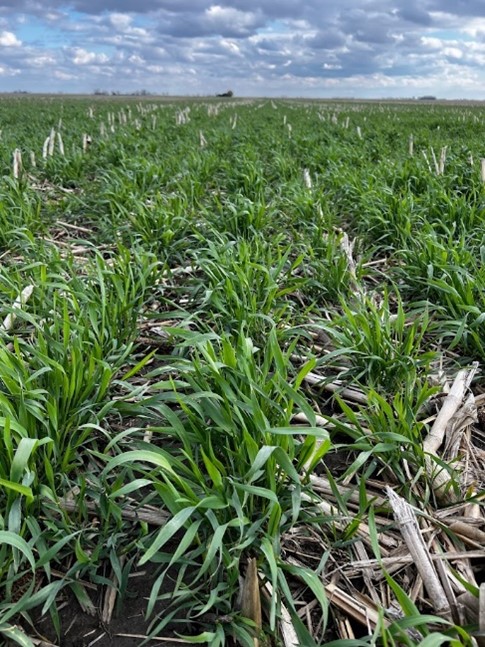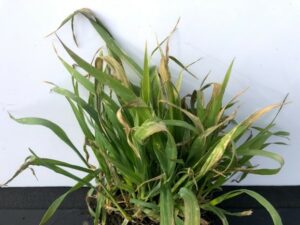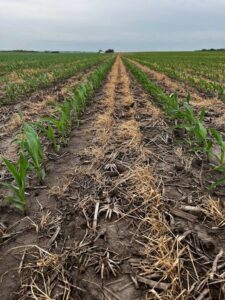This post originally appeared from the Illinois Sustainable Ag Partnership.
The following article discusses termination timing, assuming termination with herbicides. The information may not relate to termination by other means. Generally, we are considering an overwintering cereal cover crop, such as cereal rye.
What do we mean when we discuss “timing” for termination of cover crops? There are a few different considerations.
- Making the right herbicide applications based on the environmental conditions for effective uptake and successful chemical control.
- Timing of termination in relation to cash crop planting.
- Cover crop growth stage.
Herbicide Application
When it comes to effectively using herbicides, always review your herbicide labels and be aware of any plant back restrictions and other concerns. Talk with a knowledgeable applicator, preferably one with experience terminating cover crops. In my years of working with on-farm trials, chemical applicators, and my own farm applications, here are some basic pieces of advice:
- The weather needs to be warm for an extended period, not just one day, and the plants need to be actively growing.
- If you are terminating annual ryegrass you need to bring your best performance and pay attention to details. For more info, view this helpful guide by Purdue Extension.
- Cereals (such as cereal rye) tend to be relatively easy to control if you pay attention to details.
- Glyphosate is generally the best for terminating grasses.
- If you have other cover crop families in the mix such as brassicas or legumes, adding another broadleaf herbicide such as a 2,4-D is recommended.
- Watch your tank mixes for potential antagonism. Atrazine and metribuzin are the most common culprits here. When applied with glyphosate, they can make the glyphosate not as effective. The biggest concern here is with annual ryegrass, but we do see occasional issues with cereal rye as well.
For specifics on rates and proper application, refer to the label and recommendations from University Extension.
Termination Timing
The second is considering when to terminate in relation to the cash crop planting date. Generally, I consider herbicide effectiveness and cover crop growth stage to be the most important considerations when I am deciding when to terminate. The relationship between cash crop planting date and termination is an issue of identifying the most effective management strategy to deal with the weather and environment for any given year. However, there are some important points to be made here.
- Grasses should be terminated 10 days prior to planting corn.
- Planting green (planting either at or close to termination) should consider the cover crop family and cash crop family as well as the growth stage of the cover crop. Opposites attract, grasses planted green into legumes, or legumes into grasses generally work well. Avoid grasses (corn) planted green into grass cover crops (cereal rye) if possible.
- Soybeans planted green into cereal rye (or other cereal cover crops) is generally an effective strategy if the cover crop growth is not excessive. If the growth is excessive, planting green may be necessary to avoid a dead cover crop preventing the soil from drying out.
- Use caution when planting corn green into a grass cover crop, but there are times when it is warranted.
- Do not plant corn between termination and 10 days after termination of a grass cover crop.
- Planting green is advisable when wet field conditions persist. Termination of a large cover crop well ahead of planting may lead to prolonging field drying.
- A living green plant will continue to remove moisture from the soil, helping to dry out a field in a spring with excessive moisture and maintaining suitable planting conditions.
- Earlier termination should be considered in dry years when a living cover crop will remove too much moisture for cash crop germination.
- Termination of a cover crop smaller than 18 inches rarely causes much trouble in a field drying out for planting, however it may add a few days of drying time. Some years those days are critical.
- A cover crop over 24 inches terminated without immediate planting can cause issues if wet weather persists. The field will be difficult to dry out due to the biomass.
- The weather is different every year, and there will not be an answer that is correct year in and year out for all soils. Watch the weather, understand your soils and cover crops, play defense to avoid issues, and learn from your mistakes.
Cover Crop Growth Stage

Cereal rye 8-inch biomass before soybeans. Photo credit: Abigail Peterson, Illinois Soybean Association
This section is primarily considering a cover crop of cereal rye. The advice would apply to other cereal cover crops such as barley, wheat, and triticale but will be different if you have a strong stand of a legume such as clover, or other families of cover crops.
I consider the growth stage of the cover crop to be my biggest concern for when I want to terminate a cover crop. Please keep in mind that Part 1 on herbicide effectiveness is a prerequisite to this, it determines when I can and cannot terminate.
After I make sure I am meeting those requirements, then I am looking at the growth stage of the cover crop for termination, then I am determining whether planting green (Part 2) is the preferred management strategy for the conditions that year.
The reason cover crop growth stage is so important is largely tied to carbon and nitrogen ratios, and it is important for any one using cover crops to understand how this relationship works and why it matters.
That is beyond the scope of this article, but generally it comes down to how “digestible” the cover crop will be for the soil, or how fast it will break down. If we are here to feed the soil, then the quality of the feed will matter as much as the quantity. Learn more about the C:N ratio here.
- When it comes to cereal cover crops ahead of corn, the potential for negative agronomic issues means we need to terminate earlier than ahead of soybeans.
- Ahead of corn, terminate cereal cover crops at around 8 inches. If a skip row or strip tillage is used, you can increase this to 10-12 inches.
- Ahead of soybeans, terminating at the boot stage, or around 18 to 24 inches provides a great balance between quantity and quality of the cover crop biomass.
- Barley, wheat, and triticale cover crops will reach this growth stage later in the spring, and will not be as tall or have as much biomass at the boot stage compared to cereal rye.
- A cereal rye cover crop of 18 – 24 inches will be enough biomass to significantly reduce tile nitrate loss, control erosion, and help to meet the goals of the Nutrient Loss Reduction Strategy. For many growers on higher producing ground, this should be the goal.
- The actual amount of biomass will be heavily affected by the seeding rate, seeding date, spring weather, and row spacing of the cover crops. These are general guidelines, and you should observe your fields and agronomic outcomes each year to determine the best strategy for your operation.
It would be great if an article on cover crop termination could be summarized in three sentences. As it is, there is much more to consider than stated here. This article should be the beginning of your research, not an end. Adding cover crops to your operation adds life to your soil and in most cases when we deal with living things, it can get complicated. The rewards of a healthier soil, a more resilient operation, and improving the field conditions you have make a cover crop worth it. Management standards and prescriptions are difficult with soil health systems. You must learn all you can, gain experience, and make decisions based on the conditions of each year.




 and then
and then